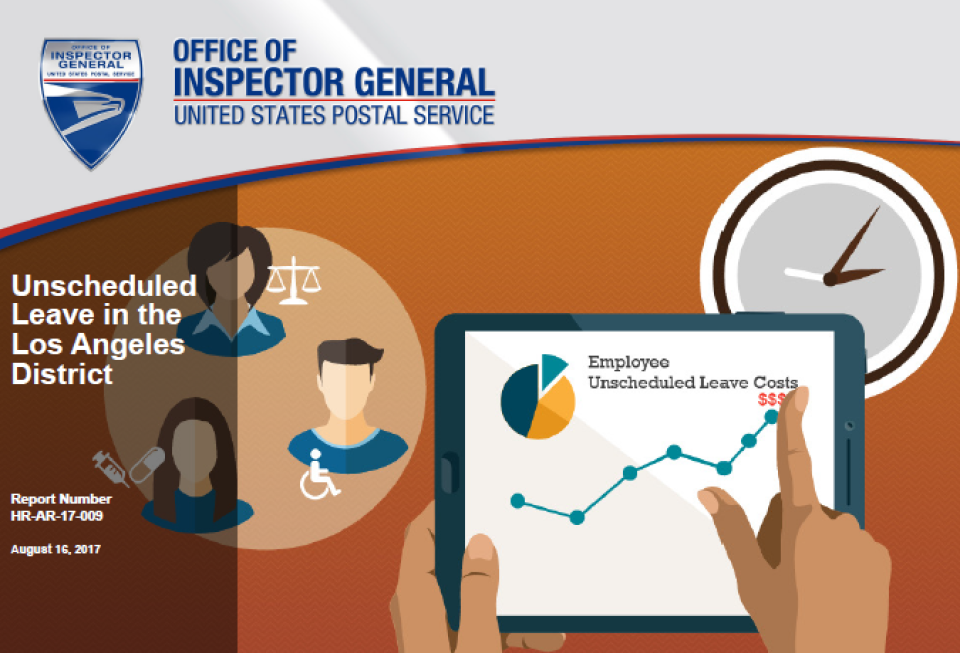Unscheduled Leave in the Los Angeles District
Background
The U.S. Postal Service categorizes unscheduled leave as any absence from work that is not requested or approved in advance. Unscheduled leave could contribute to increased compensation expenses by requiring management to increase workhours and overtime hours.
The OIG developed a Human Resource Risk Model (risk model) to monitor key Postal Service metrics, including unscheduled leave that could potentially affect productivity, efficiency, costs, and employee morale. For all four quarters in fiscal year (FY) 2016, the risk model identified the Los Angeles District in the Pacific Area as having the third highest percentage of unscheduled leave in the Postal Service. This is the second in a series of unscheduled leave audits.
Our objective was to conduct a follow-up audit to assess the management of unscheduled leave in the Los Angeles District and identify opportunities to reduce unscheduled leave and its associated costs. In addition, we will assess whether management effectively implemented the recommendations in a prior management advisory report (Unscheduled Leave Activity in the Los Angeles District, Report Number HR-MA-14-004, February 6, 2014).
What the OIG Found
The Los Angeles District did not adequately manage excessive unscheduled leave. This leave could be reduced to acceptable levels by appropriately completing required forms, enforcing disciplinary actions, and providing supervisors with sufficient training. In addition, Los Angeles District management did not effectively implement recommendations from our prior OIG management alert.
We determined that employees with a combined 88 or more occurrences of unscheduled leave during FYs 2015 and 2016 to be excessive. In FY 2016, 500 of the district’s 8,900 employees (or 6 percent) had excessive unscheduled leave, which comprised 314,431 of 880,316 total unscheduled leave hours (or 36 percent).
The top three unscheduled leave types recorded for the 500 employees were absent without leave, sick leave, and full day leave without pay, which represented 280,228 of 314,431 of their unscheduled leave hours taken (or 89 percent).
This occurred because Postal Service supervisors did not properly complete, approve, and maintain copies of Postal Service Forms 3971, Request for or Notification of Absence, which they were required to complete when employees returned to work; did not take appropriate disciplinary action against employees with excessive leave; and did not receive sufficient training on the unscheduled leave systems/processes or the disciplinary process.
Mangers at the site with low unscheduled leave occurrences stated to reinforce the policy, they reviewed call-ins every morning and made an effort to obtain employees’ signature on PS Forms 3971 upon their return to work. These practices have led to the facility having employees using a low amount of unscheduled leave.
In addition, the current oversight process for district managers to monitor unscheduled leave activity is not effective to ensure adherence to policy, adequate monitoring, or promote accountability. District Labor Relations agreed to conduct reviews of the facilities with the highest amount of unscheduled leave monthly; however, they only conducted reviews quarterly of random facilities.
In FY 2016, per our risk model, 5 percent of the employees in the Pacific Area had 20 or more unscheduled leave occurrences per 100 employees, whereas 14 percent of the Los Angeles District’s employees had 20 or more occurrences per 100 employees.
By reducing the Los Angeles District’s unscheduled leave occurrence percentage per 100 employees to that of the Pacific Area, the Los Angeles District would reduce their excessive unscheduled leave hours by 62 percent (or 116,426 hours). These hours cost the Postal Service about $2.5 million in labor and overtime costs during FY 2016.
During the audit, in efforts to reduce unscheduled leave, management implemented corrective actions of implementing a process to realign resources to match workload, and issuing three memorandums regarding approving and monitoring overtime and leave without pay. However, additional actions are warranted to fully address the factors that contributed to excessive unscheduled leave use.
What the OIG Recommended
We recommended management issue guidance and require managers and supervisors to attend training that reiterate policies and processes for managing and documenting unscheduled leave and initiating appropriate disciplinary actions. We also recommended enhancing the district’s current review process to promote supervisor accountability to follow policies for managing unscheduled leave and initiating appropriate disciplinary action.

